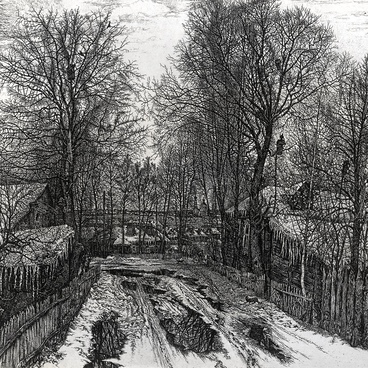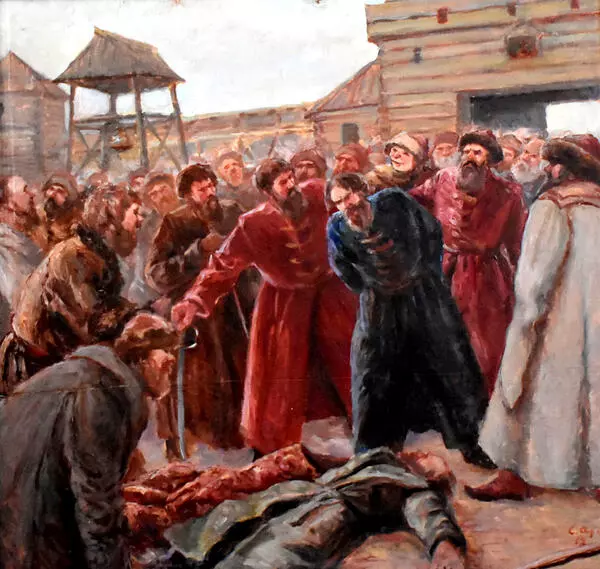The painting depicts the construction of the Kozlov fortress at the time the town was being founded. The artist elaborates on the historical subject of the construction of the town’s fortifications. Different servicemen — as they were called in Russia in the 14th–18th centuries — obliged to do military or civilian service for the benefit of the state, were brought in from the neighboring towns to build the new town. They were not paid any wages during the construction — it was their usual service. The carpenters, such as in the left part of the picture, were entitled to the following wages,
Building the Town
Время создания
1948
Место создания
the USSR
Размер
100x120 cm
Техника
oil, canvas
Коллекция
2
Открыть в приложении#4
#6
They are to be paid daily six, five and four half-kopeck coins per day from the money that was sent with them.
#7
The foundation stone of the fortress was solemnly laid on Sunday, October 11, 1635. The central part of the painting depicts the voivode (probably Ivan Birkin) personally overseeing the construction process, as evidenced by his characteristic pointing gesture. The builders, rushing to erect the fortifications before winter, built palisades — the type of the town walls which were easiest to build. They can be seen in the background on the right-hand side of the painting. Such walls were made of dense rows of logs aligned vertically. Logs were usually 3 sazhens long, with about 2 meters of the log under ground (1 sazhen = 2.1336 m). As compared to the walls fortified by assemblies of logs, the palisades had their advantages. They required less timber and allowed to reach the shoot holes faster in case of alarm. The embrasures made in the fortress walls were arranged in several rows. The shooters who fired from the upper embrasures stood on platforms, while those on the ground fired from the lower embrasures. On the downside, such walls were not very strong. However, the aim of Tatar raids was never to besiege fortresses and seize territory. Seeking to capture people and livestock, the Tatars avoided direct combat and did not stay long in one place, hurrying to leave with the booty. As time showed, the builders were not mistaken in their expectations: throughout its history, the city was never besieged.
The towers depicted by the artist in the background of the painting were arranged along the walls which formed either a square or a regular hexagon. The towers reinforced the defense line of the fortress considerably. They housed artillery and were also used for observing the enemy. The towers consisted of two or three separate stories. The floor of each story was called a bridge. The main octagonal tower was 22 sazhens high. One of the towers was placed on a 30 sazhens long secret passage, which led to the Voronezh River. In the early 1650s, the wooden fortress of Kozlov was significantly rebuilt, first by voivode Ivan Olferiev, and then by voivode Pyotr Pushkin, and after that it did not change its appearance for a long time. The fortress had 15 towers, 3 of which were drive-through and 12 blind ones. The two octagonal towers on the north and south sides were much higher than the others — 22 and 20 sazhens (47.5m and 43.2m).
The towers depicted by the artist in the background of the painting were arranged along the walls which formed either a square or a regular hexagon. The towers reinforced the defense line of the fortress considerably. They housed artillery and were also used for observing the enemy. The towers consisted of two or three separate stories. The floor of each story was called a bridge. The main octagonal tower was 22 sazhens high. One of the towers was placed on a 30 sazhens long secret passage, which led to the Voronezh River. In the early 1650s, the wooden fortress of Kozlov was significantly rebuilt, first by voivode Ivan Olferiev, and then by voivode Pyotr Pushkin, and after that it did not change its appearance for a long time. The fortress had 15 towers, 3 of which were drive-through and 12 blind ones. The two octagonal towers on the north and south sides were much higher than the others — 22 and 20 sazhens (47.5m and 43.2m).
#5
Ministry of Culture of the Russian Federation
читать дальшескрыть
00:00
00:00
1x
Building the Town
Время создания
1948
Место создания
the USSR
Размер
100x120 cm
Техника
oil, canvas
Коллекция
2
Открыть в приложении
Поделиться



